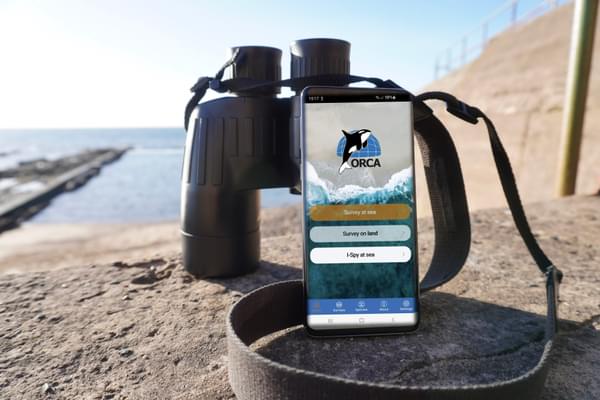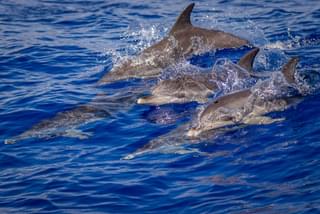Orca (killer whale)
/SMJ_4616.jpg?w=1400&h=600&q=85&auto=format&fit=crop&crop=focalpoint&fp-x=0.5086&fp-y=0.4799&dm=1684241020&s=a3dca0eeeb399945cae8a40e6797d27a)
Orcinus orca
5 - 10m
Black
Teeth
Dorsal fin
The orca is one of the most familiar and well-known cetaceans. Despite its original name, ‘killer whale,’ it is actually the largest member of the dolphin family. They are easily recognisable with their black body, white patch behind its eye, a white chin and underbelly and a white/grey “saddle” behind its dorsal fin. The intensity of the black and white across the body varies between different populations. The males are particularly recognisable with their tall, straight dorsal fins, whilst the females have a shorter, more curved fin.
Keay features:
- Pointed, black head, white eye patch and white lower jaw
- Males dorsal fin is straight and 2m tall
- Females dorsal fin is smaller and curved
- Pale grey saddle patch behind the dorsal fin
- Active, often breaching
Behaviour
Orcas are sociable and inquisitive creatures, travelling in groups of 2 – 30 discrete family groups. They are fast and active, often demonstrating breaching, crashing and spy-hopping behaviours. They have a relatively small, bushy blow, only visible at close range. Despite the nickname killer whale, they have never been known to show aggression to humans in the wild, and rarely amongst themselves. The name originates from the nickname “whale killer” given to them by fishermen after observing killer whales hunting larger species of whales.
Threats
Orcas were once captured in large numbers for aquariums and sea parks, and although there are still a number of individuals in captivity throughout the world this number has significantly declined in the last two decades. In the wild orcas are at risk from pollution and the depletion of their prey. They also suffer from accumulation of contaminants in their bodies. Marine animals cannot process contaminants; this means that the concentration of contaminants steadily increases as you move up the food chain. By the time the contaminants have reached the orcas at the top of the food chain they reach dangerous levels which can affect their long term survival.
Distribution
Orcas have a cosmopolitan distribution, from tropical to polar waters, and from surf zone to open sea, but they are patchy, most common in cool, high-latitude waters. In certain areas of the world, there are thought to be two distinct forms of orca; transients and residents. Transients typically form small pods of 1-7 individuals and roam over a large area feeding predominantly on mammals. Residents tend to form larger pods of 5-25 animals and have smaller home ranges, feeding mainly on fish. It has been recognised that there are different ecotypes of killer whales that differ morphologically and biologically, with different specialised hunting strategies seen between the different ecotypes.
/IMG_7387.jpg?w=900&h=600&q=85&auto=format&fit=crop&dm=1683137498&s=c21d1751969ee8fa0993670414fb79f9)
/IMG_8981.jpg?w=900&h=600&q=85&auto=format&fit=crop&dm=1684240874&s=e66d5dcebb7b156ea3908a29968f8dc7)
/Photo%20Library-311.jpg?w=900&h=600&q=85&auto=format&fit=crop&crop=focalpoint&fp-x=0.767&fp-y=0.2925&dm=1684240896&s=3a3cba58cfbba075b6a057fd24dc64f5)
/Photo%20Library-356.jpg?w=900&h=600&q=85&auto=format&fit=crop&dm=1684240838&s=bfec3c8538b5ee352b7e448111fdd040)
/SMJ_4616.jpg?w=900&h=600&q=85&auto=format&fit=crop&crop=focalpoint&fp-x=0.5086&fp-y=0.4799&dm=1684241020&s=618b49c561610b85505a3bcbc6300500)
/2022%2006%2002%20-%20ORCA%20-%207560-.jpg?w=900&h=600&q=85&auto=format&fit=crop&dm=1683137498&s=924f70159f073ab8a49d9bdd7c0085f7)

Study whales and dolphins as an ORCA OceanWatcher
The ORCA OceanWatchers online training course, along with a bespoke app, will enable everyone to collect data about whales, dolphins and porpoises. And it can be collected from anywhere that you can see the sea - whether that’s from your local beach, on holiday at the coast, scanning the seas from a cruise ship, travelling via ferry, or from your own boat.
You may also be interested in



